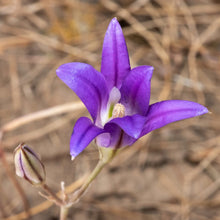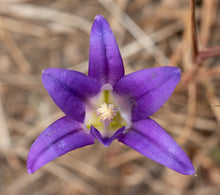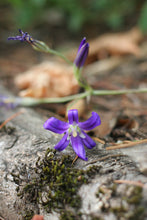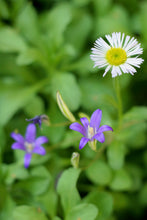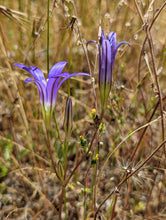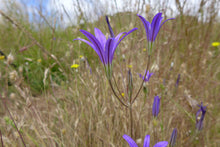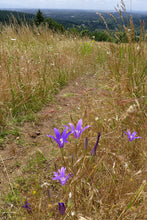
Brodiaea elegans
Harvest brodiaea is also known as "elegant brodiaea" or "elegant cluster-lily" because it is simply gorgeous. The foliage is minimal, just a few linear basal leaves that dry up as flowers appear. But, as the name also suggests, its showy clusters of purple blooms appear later, and hold out longer, than other brodiaea species. Add this drought-tolerant and fuss-free wildflower to your sunny, dry or moist meadow areas, with medium to slow draining soils, for a vibrant splash of late spring or summer color. You’ll also be thrilled with how this plant spreads over time, creating marvelous purple drifts throughout your wildflower beds.
- Plant type/canopy layer: deciduous, perennial, herbaceous plant
- Size at maturity: 12-18" tall, 6" wide
- Light requirements: full sun, part-sun/part-shade
- Moisture requirements: dry to moist soil (should become bone dry in summer)
- Growth rate/ease: medium growth rate, moderately easy to grow
- Bloom time: May - July
- Wildlife support: flowers attracts and provide nectar to adult beetles and native flies
- Native range: found growing in meadows, dry hillsides, open grassy areas, and forest edges and openings, from sea level to 1500m, from the coast to the Cascades of western Oregon and northwestern California. Portland Plant List - no.
- Special features & uses: drought tolerant; ok with slow-draining clay soils; spreads beautifully over time; bulbs/corms are edible and traditionally dug by indigenous people with long sticks and consumed raw or cooked; landscape uses include meadowscapes and raingardens
Gardening with Harvest Brodiaea: Simply plant this wildflower in full sun to bright shade to enjoy the most prolific blooms. It prefers medium or slow drainage, including clay soils, but can tolerate bourgeois garden soils. It doesn’t take up much space at all, so be sure and interplant several for the most striking effect. After it blooms in late spring and early summer, it will die back completely until the following year. It's best to keep this one away from irrigation and to let it dry down completely after it flowers. Accidentally watering its planting area too much during the summer months could cause its bulb-like root structure to rot.
Plant this beauty in a wildflower meadow, rock garden or sunny raingarden with other species that thrive in similar conditions, such as wild alliums (Allium acuminatum, Allium cernuum), mariposa lily (Calochortus tolmiei), showy milkweed (Asclepias speciosa), farewell-to-spring or diamond clarkia (Clarkia amoena or Clarkia rhomboidea), California poppy (Eschscholzia californica), blue gilia (Gilia capitata) and/or lupine (Lupinus sp.).
Photo Credit 1 & 2 (flower/bud, flower inside): © Don Loarie, some rights reserved (CC-BY)
Photo Credit 3 & 4 (flowers close, flower with fleabane): Karli Del Biondo, Beetles and Bees
Photo Credit 5 (flowers/side view): © Logan J.L. Bradley, some rights reserved (CC-BY)
Photo Credit 6 & 7 (in a meadow): © Don Boucher, some rights reserved (CC-BY)







